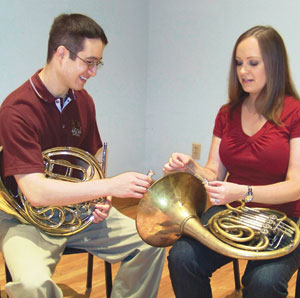
Horns require periodic maintenance to remain in top condition. Even high-quality instruments deteriorate over time if their owners do not treat them with care. While only qualified repair professionals should handle difficult procedures, such as removing dents, chemical and ultrasonic cleaning, and adjusting and repairing rotary valves, educators and horn students can save both time and money by following correct horn maintenance techniques.
This guide includes step-by-step descriptions for a variety of fundamental maintenance techniques along with photographs for the more complicated procedures. Easier techniques are presented first followed by more difficult ones.
Type of Maintenance
Oil Valves
Frequency
Every 1 to 3 days
Equipment
For optimal performance on horn, I suggest using a thin, light oil, which should be applied directly on the valves, and a medium-weight oil for the bearings. As a rule you should avoid mixing synthetic and petroleum-based oils, unless the products’ labels state in writing that they are compatible with each other.
Description
There are two types of techniques for oiling rotary valves, and they differ simply because of the variations in size and shape of valve oil bottles. Some bottles come equipped with a needle while others have a less-precise dropper or spout.
Inexpensive refillable plastic bottles with needles can also be purchased on the internet, giving players the freedom to use the oil they prefer regardless of the original container.
Oil Bottles With a Needle
1. Remove the first valve slide and empty any condensation. Next rotate the horn so the bell and the slide tube point directly up.
2. Insert the needle into the slide tube and squeeze a few drops of light-weight oil directly onto the valve.

Avoid letting the needle come in contact with the sides of the tube or the valve face. Repeat this step for the other side of the tube if desired.
3. Replace the slide and push it in completely. Finally, rotate the horn and depress the valve so that the oil is distributed evenly inside the valve casing.
4. Repeat steps 1-3 for each valve. An alternate way to use a bottle with a needle is to remove all of the slides and add oil to all the valves simultaneously. Once the horn is oiled, return the slides to their original positions.
5. Lay the horn flat and unscrew the first valve cap. Apply a few drops of the medium-weight oil to the center of the bearing plate and a drop onto the threads.
.jpg)
Keeping the threads lightly oiled will prevent the caps from becoming stuck if you store the horn for a long period of time.
6. Screw the cap back on and flip the horn over. Using the needle, apply a few drops of oil where the rotor shaft comes out of the valve casing.

On most horns there is a small gap between the stop arm and the rotor shaft.
7. Repeat steps 5-6 for each valve.
Oil Bottles Without a Needle
1. Remove the first valve slide and empty any condensation. Next squeeze a few drops of the lightweight oil into the slide itself.

2. Rotate the horn so that the bell and slide tube are facing directly down.
3. Replace the slide and push it in completely.
.jpg)
4. Rotate the horn and depress the valve so that the oil is distributed evenly inside the valve casing.
5. Repeat steps 1-4 for each valve.
6. Next follow steps 5-7 from the method for using a bottle with a needle.


Additional Tips
Many repair professionals recommend blowing a few drops of light- weight oil down the lead pipe and through the horn at the end of each playing day. The idea is to create a thin coating of oil inside the horn, protecting it from corrosion. Medium or even a heavier-weight oil can also be used on valve springs as well as mechanical levers.
Whether using a bottle with or without a needle, both methods prevent the oil from carrying slide grease and any other material into the valve. Many players experience sluggish valves after applying oil because of slide grease gumming up the valve action.
If applied regularly and correctly, valve oil will prolong the life of a horn and keep it in good working condition for long periods of time. However, if regular oiling does not result in improved valve operation, it is probably time for a thorough cleaning and possibly repair of the valves themselves.
Type of Maintenance
Cleaning the Lead Pipe
Frequency
Every 1 to 3 weeks
Equipment
I recommend using a plastic coated snake with brushes on either end to keep the inside of the horn from being scratched.
Description
This simple procedure is vital for keeping a horn in good condition. If left alone, debris will accumulate in the lead pipe only to be blown into more difficult-to-clean places in the horn, such as the valves, causing even more problems. Hornists should combine this step with good dental habits, such as brushing the teeth after meals.
Type of Maintenance
Clean and Grease Slides
Frequency
Every 1 to 3 weeks
Recommended Equipment
I like Schilke, Hetman, or Roché-Thomas slide grease. For loose slides look for a slide grease with a thicker consistency.
Description
1. Remove all slides, then wipe them clean and dry with a paper towel or soft cloth.
2. Apply a small amount of grease to the end of the slide using a finger or the corner of a cloth. You can always add more if necessary.

3. Replace the slide and push it in completely.

As you replace the slide, the grease will be evenly distributed.
4. Wipe away excess grease.
5. Repeat steps 1-4 for each slide.
Additional Tips
I suggest periodically removing the excess corrosion that accumulates on slides using a mild metal polish. You should consult the manufacturer’s instructions for using the polish. After removing the corrosion, clean the slide thoroughly with warm water and mild dish soap to remove all traces of the polish.
Follow steps 2-5 to complete this procedure. Always grease horn slides and push them in completely during the summer months or for long periods when you are away from the instrument to prevent them from freezing.
Type of Maintenance
Restringing Valves
Frequency
Yearly
Recommended Equipment
Numerous brands of string are available from music supply warehouses and sporting goods stores for restringing valves. Although most professionals have their own preferences, I recommend choosing a braided dacron fishing line of not less than 50-pound test. This type of line can be purchased in spools of several hundred yards, giving players – indeed, entire sections – string for many years.
It’s best to avoid overly thick string because using it can result in sluggish valves, and string that is too thin may wear out prematurely. Advanced players should experiment with strings of different weights and thicknesses to find the optimum choice for a particular horn. The only other necessary equipment for restringing valves is a good set of flathead screwdrivers in varying sizes.

Description
Along with oiling the horn correctly, regularly restringing rotary valves will keep the instrument in excellent playing condition. I suggest replacing strings every year, regardless of their condition, because you will avoid the frustration of breaking a string just before a big performance. Serious horn students should learn this procedure and practice it several times to become comfortable with it.
1. Loosen the screws on both the stop arm and valve lever with the correct size screwdrivers. It is unnecessary to remove them completely, just enough to remove the old or broken string. I recommend that beginners remove the string only from one valve at a time so that the other valves can be used as a guide. 
2. Cut a 6-to-8 inch length of replacement string from the spool, and tie a firm knot approximately 2 inches from one end. You may need to tie several knots on top of each other because it is important for this knot to be large enough to not pull through the hole in the middle of the valve lever. Pull the knots tight, so they do not slip.

3. If the string tends to fray, use a lighter or lit candle to slightly melt the end opposite of the knot. Wipe off the melted end with a paper towel or cloth to create a pointed tip that will thread easily through the holes in the valve lever. Manufacturers are constructing some of the newer types of string from material that resists fraying, so this step may not be necessary.
4. Thread the string through the hole in the middle of the valve lever, making sure the knot is large enough to stay in place.

5. Following the diagram, wrap the string around the stop arm on the side furthest from the middle valve lever hole, and make a figure eight around the stop arm screw. Tighten the stop arm screw, but only enough to keep the string from slipping.

6. Bring the string around the other side of the stop arm and under itself. Thread the end through the hole in the end of the valve lever.

7. Keeping the string snug, loop the end around the screw in the end of the valve lever. Pass the end of the string underneath itself, as if tying another knot.
.jpg)
Tighten the screw in the end of the valve lever and cut off the excess string.

Leave at least an inch or so at the end to use in adjusting the string tension later.
8. Repeat steps 1-7 for additional valves.
9. Loosen the stop arm screw and adjust the valve lever to the height you desire. Retighten the stop arm screw to keep the lever in place. All of the levers can be set at the same height by using the edge of a table to keep the levers in place while loosening and retightening the stop arm screws.
10. Check the tension on each string.

The strings should move easily, but not be so loose that they fall slack against the stop arm when the valve is depressed. Adjust the tension by loosening the valve lever screw and pulling the string tighter or allowing it to loosen as needed.
Additional Tips
Every horn player should keep an emergency repair kit handy that has a selection of small screwdrivers and replacement strings, precut and tied. Should a quick string change be necessary, having the materials at hand will make the process easy.
Special Web Extra: More Horn Maintenance
Horn maintenance can also be viewed on the internet at www.youtube.com/watch?v=h x3-zNotyTo&feature=channel.






